Today’s guide is a really important one because I’m going to teach you how to navigate and deal with the most difficult market condition in all of forex…
Consolidations!
Along with trends, consolidations are one of the three key market phases you need to navigate in forex… and by far the trickiest. A single consolidation can whipsaw you for days, leading to many nasty, unnecessary losses – losses that could’ve been avoided had you properly understood the conditions correctly.
Luckily, getting to grips with consolidations isn’t that hard. And once you know a few key facts about how and why they form in the market, they become very easy to deal with.
So, here’s what we’re going to cover:
- What is a consolidation and what does it signal?
- The psychology behind why consolidations form.
- 3 tips for trading consolidations safely.
- How to predict when a consolidation will end using stop hunts.
Lets start by doing a quick overview of what consolidations are, so we’re all on the same page for the rest of the post.
Overview Of Consolidations
If this is your first time learning about consolidations, stick tight, we’re going to cover them in great detail in a minute.
However, if you have a few solid years of trading under your belt and know what consolidations are and how they form, it’s best to skip down to the latter sections…
– I’ll give you the low down on why they form, i.e – the psychology behind them.
– And I’ll also give you my top 3 tips for trading them safely – you don’t want to miss this, trust me.
So, let’s jump in and talk about what consolidations are…
The simplest way to describe a consolidation is a period in the market where price moves sideways rather than predominately up or down, such as in a trend, for example.
Price movement is made up of three phases: uptrends, downtrends, and consolidations.
Trends are what cause price to move and change; they represent the overall consensus in the market. Consolidations, on the other hand, signal the opposite: indecision. They show traders aren’t sure which direction price is going to move in next. As a result, price moves sideways to reflect their confusion.
Now, if you’ve been trading for a while, chances are, you’ve seen a consolidation or two yourself.
Forex is one of the most consolidation heavy markets out there, if not the most.
Some people estimate they account for more than 80% of the movement we actually see in the market – with uptrends and downtrends being the remaining 20%. That means you’re going to see them… A LOT. So it really pays to understand why they form so you know how to deal with them properly – more on this later.
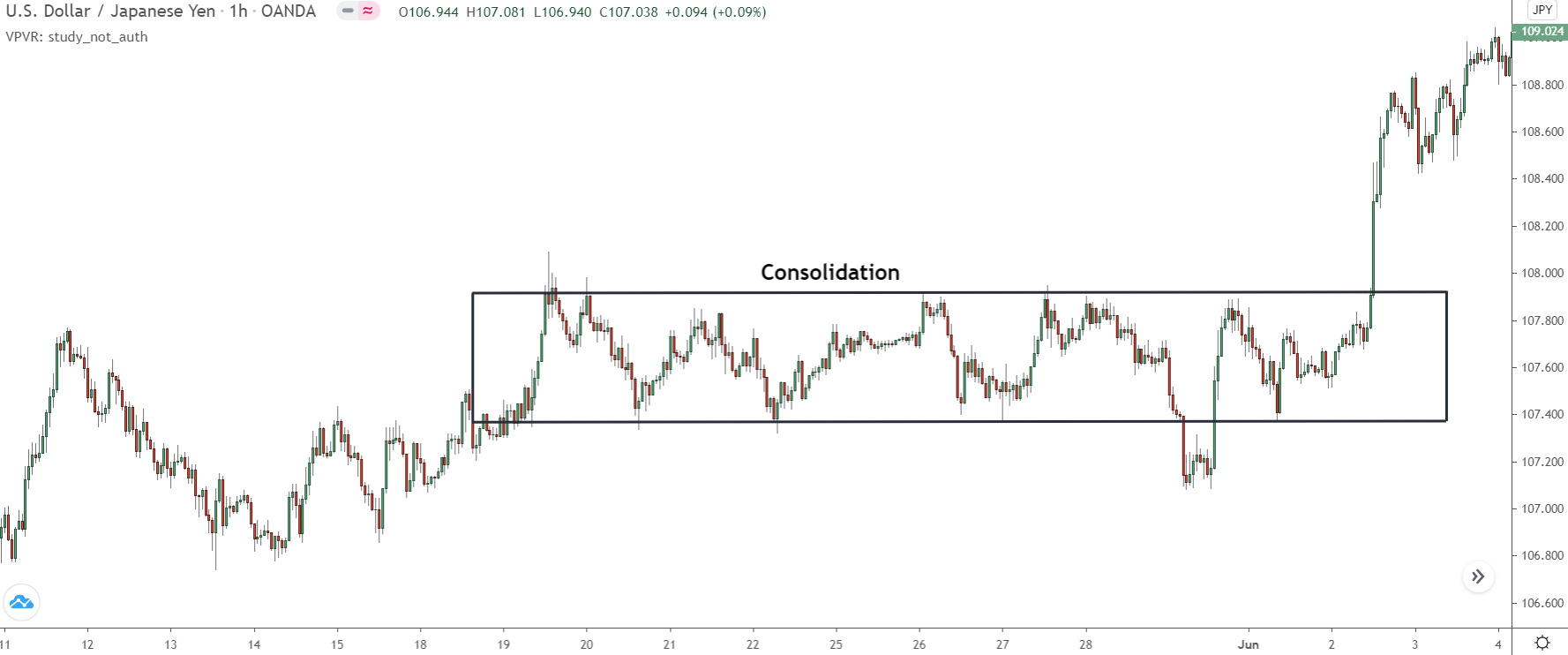
So, here’s what your typical consolidation looks like.
As you can see, it forms from price moving sideways: it swings down, then back up, down again and so on…
All consolidations you see, no matter which currency or time-frame they form on, follow this same basic pattern. They’ll never look exactly the same, but they’ll all have relatively equal swings that result in price moving sideways – the longer the timeframe, the longer the consolidation will last.
Keep in mind, too… consolidations can signal either a reversal or continuation.
Most of the time, they form mid trend, signaling a small pause before a continuation. However, sometimes they also form at the end of trends, indicating a reversal.
There’s no way to know, for sure, which one it’s going to be – though 80% of the time, it’ll be a continuation, due to how rare trend reversals are in the market. That said, there are a couple of hints that signal it’s more likely to be one over the other, which I’ll walk you through later on in the guide.
The Psychology Behind Why Consolidations Form
While it’s important to know what consolidations signal (confusion), it’s even more crucial to understand why and how they form in the market – and this is what we’re going to look at next.
Consolidations represent confusion; that we now know.
But it’s only confusion on the part of retail traders – traders like you and me, in other words.
The big traders, those who work in banks, hedge funds, and the like… they aren’t confused during consolidations. In fact, they use consolidations for their own purposes. And actually cause them to form in the first place for this very reason – sneaky, right?
How do they do this? Let me break it down for you…
All consolidations start with the banks taking profits off their trades, that’s what causes price to move in the opposite direction and form the first swing in the consolidation – which, at the time, many believe is simply a retracement to the current trend/move. There are two reasons they could be taking profits…
1. They want price to reverse as the trend/movement has run its course – this means the banks are using the consolidation to place trades in the opposite direction.
2. They want trend/movement to continue, but it’s become too obvious to everyone, so they need to confuse everyone (which is what consolidation signals, remember) to mess up traders’ expectations about the future.
Now, which one it is doesn’t matter; they all form in the same way with the same structure.
The only different thing is the outcome: #1 results in a reversal; #2 in a continuation. You won’t know which it’s going to be beforehand (though there are signs, some of which I’ll explain later on), but in any case, it’ll be one of the two.
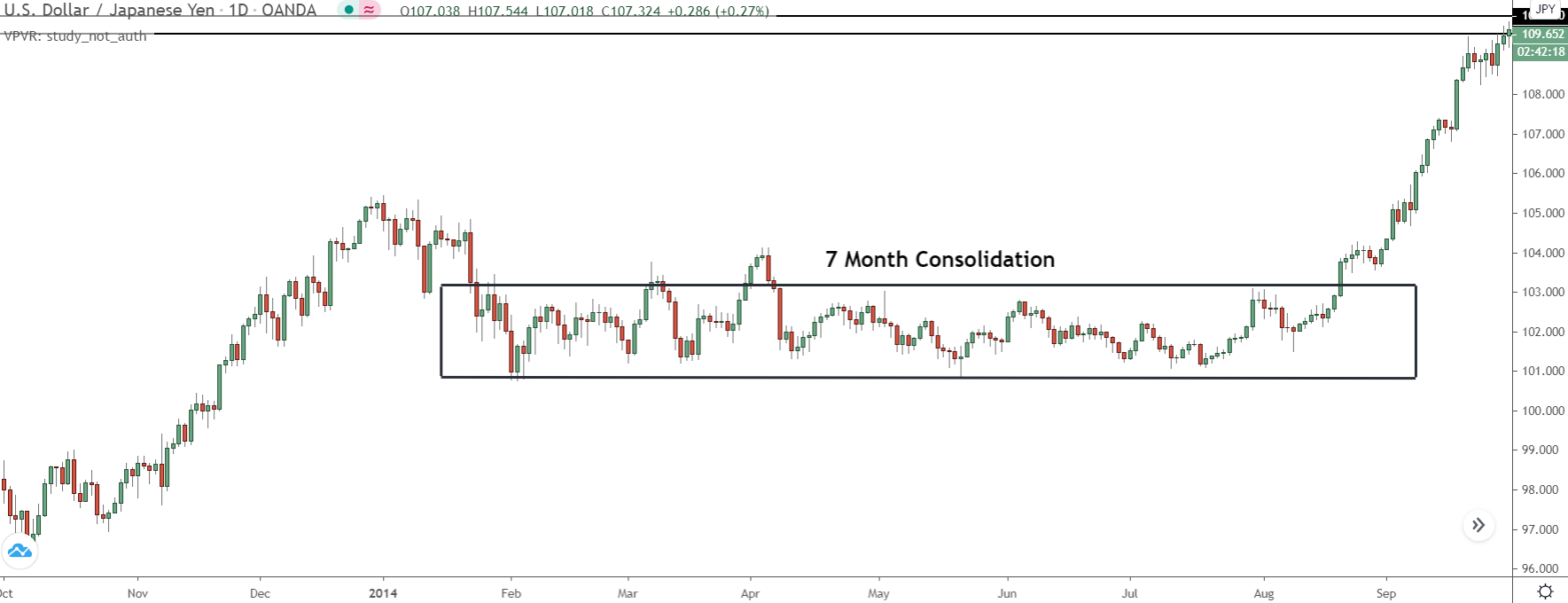
Here’s a consolidation from a few years back on Usd/Jpy.
This consolidation formed after a significant up-move and resulted in a continuation, which means the banks created it for reason #2 listed above. Lets breakdown how this consolidation formed, so you can see how the banks placed their trades.
So first, the banks decide to take profits off their longs causing a counter-trend movement.
No-one knows it at the time, but this downswing is the first swing in the consolidation.
All subsequent swings could terminate near the swing high and low of this swing, depending on how the consolidation takes shape, making them key points you need to watch for signs of a reversal.
At some point, the banks decide to place buy trades. This is when the downswing ends, and price begins moving higher again.
Again, we don’t know this at the time; it just looks like a retracement to us.
However, knowing the consolidation resolved to the upside, it becomes obvious that this is the case and where the banks placed their first set of buy trades in this consolidation.
As price moves back up again, retail traders – traders like you and me – start going long; they think the upswing is a resumption of the prior up-move. The banks know this, and in fact, want everyone to go long.
They still haven’t taken profits off all their prior longs, so they need people buying again to even make a profit.
Once price reaches the highs of the first downswing, the banks decide to take profits again, setting off another downswing and causing most of the long retail traders to lose money. As a result, price falls back to the low of the first upswing.
You can probably already guess what happens next, right?
With price back at the low (or thereabouts), the banks decide to buy again.
Remember, the banks always place their trades (and take profits) at similar prices. It keeps their risk even and their profits relatively equal – the same as placing one trade at a single price, which they can’t do because not enough people are buying or selling.
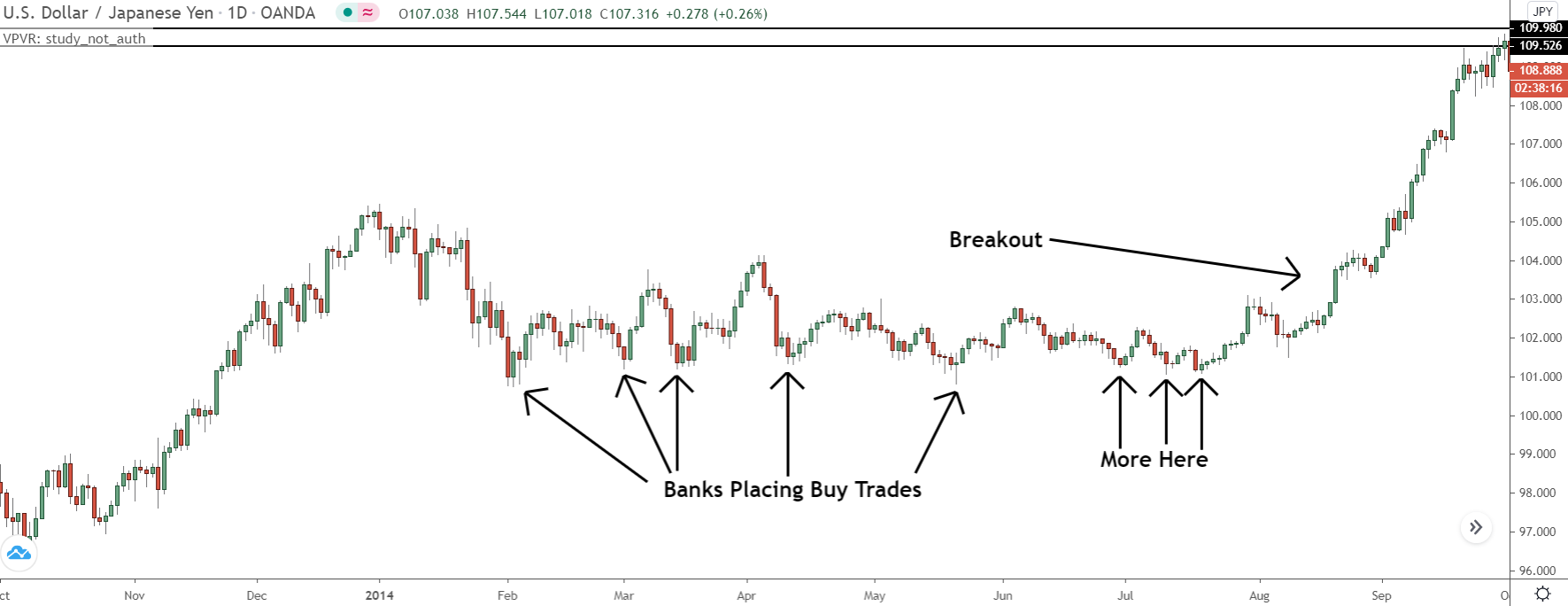
This pattern of the banks buying at the lows, taking profits at the highs then continues, until eventually, they’ve managed to get all their trades entered.
With everything placed, the banks now cause the breakout.
Usually, this will come without any prior warning. Sometimes news acts as a catalyst, but not always, and you never know which event could kick it off – it’s a coin-flip really. In some cases, you’ll see a stop run beyond the opposite side of the consolidation just before price swings to the other side and breaks out.
This doesn’t happen often, but when it does, it’s typically a great signal the breakout is about to begin.
– I’ll walk you through how this works later on.
And there you have it, that’s why and how consolidations form in the market – interesting, right?
My Top 3 Tips For Trading Consolidations Safely
To deal with consolidations correctly and not suffer any silly, unnecessary losses, you’re going to need a few pointers on what you should (and shouldn’t) do when they form.
And that’s what this final section is all about.
I’m going to give you my top 3 tips for trading consolidations safely.
These tips will stop you from doing anything stupid when the consolidation forms. They’ll also give you some idea of when it might end, and also how large the breakout move will be.
Let’s jump in and look at tip #1…
#1 Don’t Use Levels/Zones In The Middle Of The Consolidation
One of the biggest mistakes you can make trading consolidations is taking trades from levels and zones located in the middle of the consolidation rather than at the extremes.
Hands up if you’ve made this one before – I know I have.
Taking trades from the mid-levels/zones doesn’t seem like a problem – it can even get you into some good trades from time to time. However, aside from the odd trade, these points rarely result in reversals. And if you understand how and why consolidations form, it’s easy to see why.
Consolidations always follow the same basic pattern…
Price moves from one side of the consolidation to the other, then it moves back again, and after that back to the other and so on.
It moves like this because the banks are placing their trades ready for the breakout.
The banks can only buy and sell when they have traders doing the opposite; buying if they want to sell, selling if they want to buy. That’s why price swings up and down. The banks place their trades then bring price back to the same spot to get people to buy/sell again so they can get more trades placed.
And herein lies the reason the mid-level/zones rarely result in reversals.
Since they always place their trades at similar prices, the banks don’t want price to reverse from the middle of the consolidation; it would mess up their positions because those trades wouldn’t make the same profit as the others – the trades placed at the extremes, which all make a similar amount.
Here’s an example to explain further…
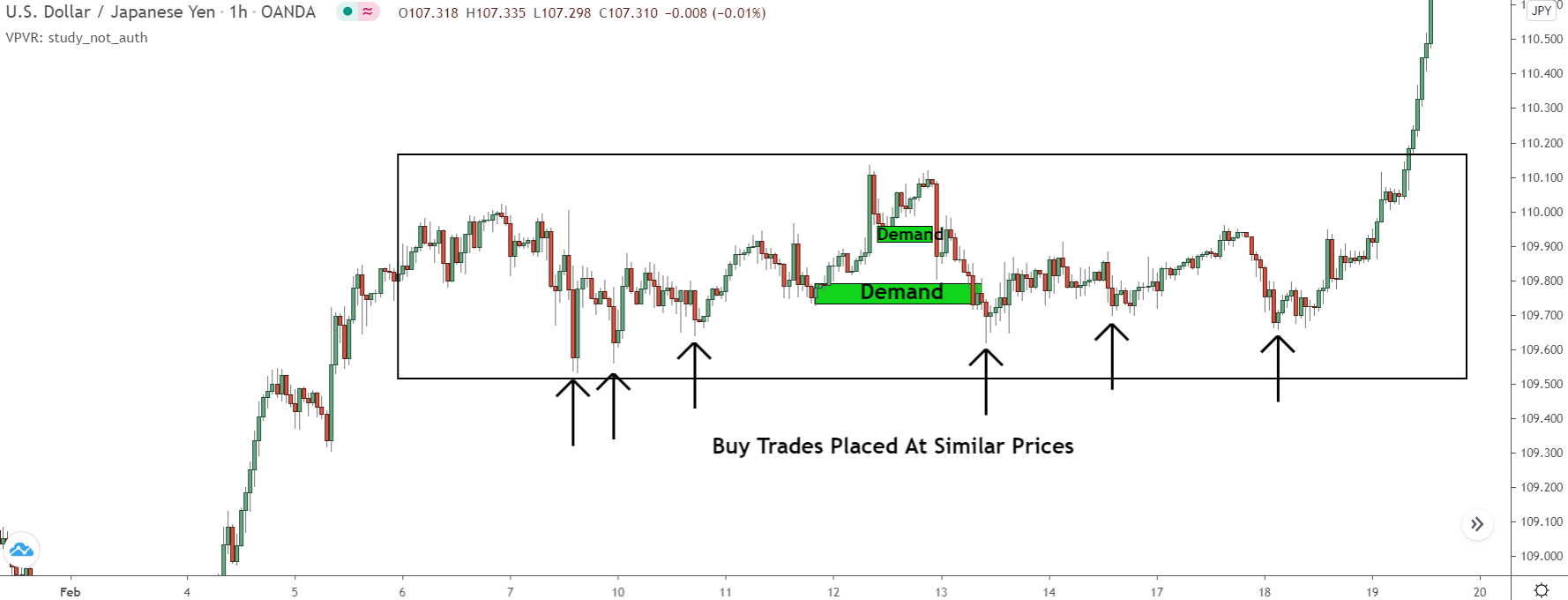
The lows of this consolidation, which the banks create from placing buy trades, all form at similar prices. So each will make a similar amount of profit once price breaks out.
But if they decide to place a few trades at the mid-levels/zone, that won’t be the case.
For example, if they bought at the demand zone I marked, that trade would make less than those placed at the lows as it’s entered at a higher price. Additionally, once price falls past the entry price, it’ll cause the trade to turn negative, costing the banks money on the charges and commissions they have to pay.
Does that make sense then, about why mid zones levels usually fail?
The banks can’t use them because it hurts the trades placed at the lows or highs.
It’s not the zone or level itself that’s the problem – why many traders think it fails – it’s the fact the banks want price to return to the point where they placed their other trades, so they can get the rest executed at the same price.
#2 The Bigger The Consolidation, The Bigger The Breakout
I figure quite a few traders know this one already, but I wanted to mention it anyway for those who didn’t… it’s pretty important, so I thought I better add it in somewhere.
The size of a consolidation, both in terms it’s overall structure (determined by the time-frame it forms on) and the time it lasts correlates to the size of the breakout you’ll see once it resolves; consolidations that last for a long time should result in a larger breakout, as should consolidations that form on a high time-frame.
Why this strange correlation you ask? Really, it comes down to two things:
1. The number of traders involved in the consolidation.
2. The size of the trades the banks place to cause the consolidation to end.
Consolidations become more and more obvious over time. As price swings back and forth, the consolidation becomes more pronounced, which leads many traders to believe it’ll continue indefinitely and further view it as a trading opportunity – since price keeps rising and falling from the same points.
So the longer the consolidation, the more traders who participate in it.
Why does this affect the size of the breakout?
Because it means more traders will lose when price eventually breaks out! Think about it… many, if not most, of these traders, are going to get it wrong and be on the losing side of the market. When they close their trades, that’s going to add more momentum to the breakout, because remember…
You close a losing trade by doing the opposite of what you did to place it; to close a sell trade, you buy back what you sold; to close a buy trade, you sell what you bought.
If thousands of traders are short, for example, when a consolidation breaks to the upside, most will close their sell trades at a loss by buying back what they sold. That’s going to unwittingly create more buying pressure, causing price to rise further and making the breakout much more explosive – does that make sense?
And with that, let’s switch gears and look at the role the banks play…
In addition to the above, the size of the breakout also depends largely on the size of the bank’s trades, which are determined by the time-frame the consolidation forms on; the higher the time-frame, the larger their trades and the bigger the breakout will be.
In forex, the banks are active on all time-frames, both high and low.
However, they only trade according to the three main timescales: short term, medium-term, and long term. These timescales are represented by the following time-frames:
5 min – short term
1 hour – medium term
Daily – long term.
Now, while bank traders have a lot of money regardless of the timeframe they trade, the longer-term traders have more because #1 it takes more money to move price on longer timescales, and #2 their outlook is much longer than the others. And that scales based on the timeframes…
So 1h traders, for example, have a lot more money than 5 min traders, and daily traders even more than them.
But what’s this got to do with consolidations, why is this all-important?
Well, the more money you have, the larger the trades you can place.
Longer-term traders can place significantly bigger trades than their shorter-term counterparts, resulting in much larger consolidations and stronger breakouts.
And if you think about it, it makes perfect sense!
A bank trader on the daily is placing trades according to what he thinks about the future price weeks or even months from now. A 5-minute trader, on the other hand, is only concerned with the next few hours. He only needs to move the market a few pips, whereas the daily traders must make it move hundreds, potentially even thousands!
That’s why consolidations on higher timeframes result in larger reversals; the banks place bigger trades because they need to market to move further.
It’s an easy concept to grasp, but not one many traders get because of all the misinformation out there.
Anyway, let’s move on to my third and final tip…
#3 Consolidations Often End After A Stop Run
For the most part, consolidations will end without any prior hints or warning – price will breakout, and that’ll be that.
However, sometimes the breakout will come after a stop run past the opposite side of the consolidation, making it a great early warning signal of which direction price will breakout – a signal you can use to get yourself into a good trade.
To understand why this happens, we need to talk again about the banks.
The banks can’t place all their trades at once, as I explained earlier. They wish they could, but they can’t. As a result, they split them up and place them at different (but similar) prices. That has the same effect as placing one gigantic trade at a single price – something they can’t do due to their trades being so big.
As well as this method works, it’s not foolproof…
Sometimes, the banks place such big trades they still can’t get them all placed, even after splitting them up! So, they have to look for alternate ways… and what’s the most common?
A stop run, of course.
With a stop run, the banks can get easily enter their remaining trades without much hassle.
All they need to do is push price into a large build-up of stop-loss orders… the stops will act as a counterparty and allow the banks to place their remaining trades without needing other traders to come into the market. It’s quick, easy, and gets them entered at a favorable price – a big win for the banks.
So, how do the banks cause a stop run?
Let’s take a look…
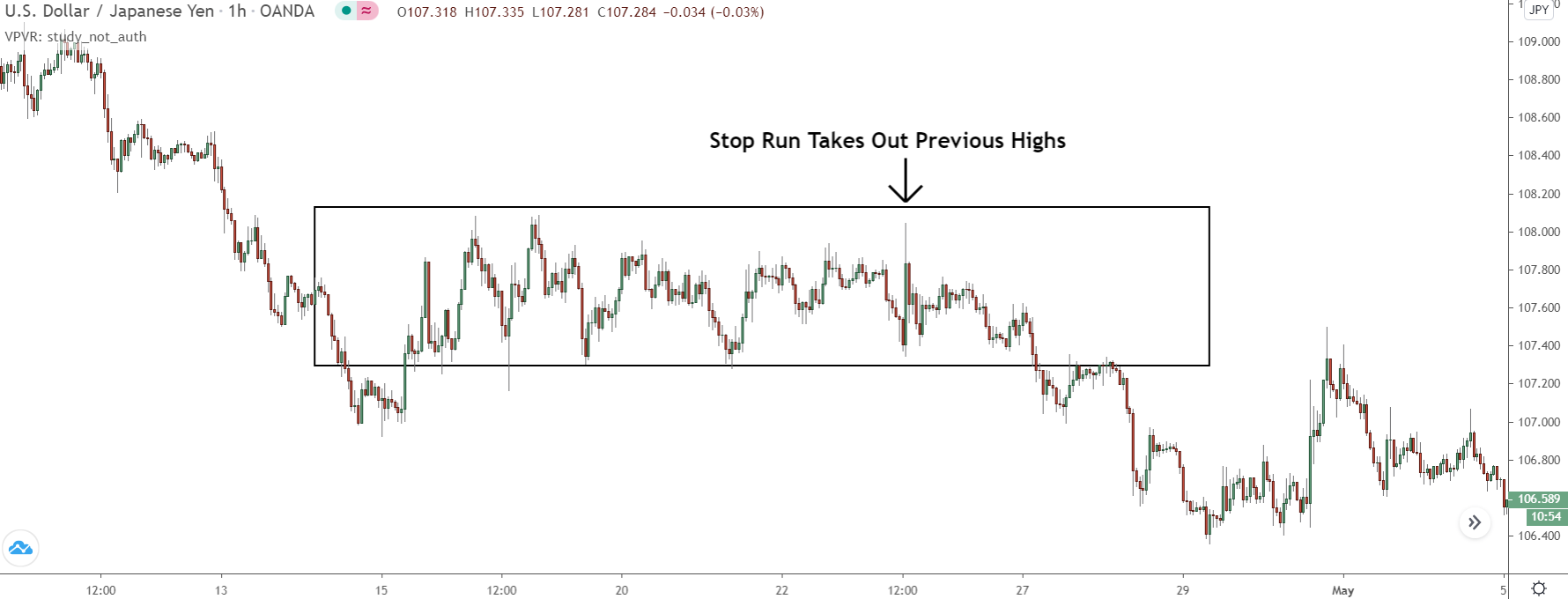
Before this breakout, price triggered a bunch of stops below the 108.000 level – slightly above the swing high created from the last downswing. How do I know this is a stop run rather than a normal spike?
Well, where do traders typically place their stop after a decline?
Above the most recent swing high, right?
So when price dropped and formed the last downswing, a whole swathe of traders decided to put their stop above the high, thinking it’s safe – which it wasn’t. The banks can see this, of course. They know stops have accumulated down here, so if not enough traders buy on the way back up, they know they can use these orders to place their last sell trades.
And as it turns out, that’s exactly what they do…
For whatever reason, not enough traders buy on the way up… the banks can’t get place their last sell trades. They need to find more buyers, so decide to push price above the high to trigger the stop orders. They’ll act as the additional buyers they need to place their remaining sell trades.
Once price hits the stops, the banks place their trades, resulting in a reversal.
Price then moves lower before breaking out, putting an end to the consolidation and resuming the previous downtrend.
Simple.
Summary
Well, that about does it for today. I hope this guide has given you a better understanding of what consolidations are, how they form, and some key tips you can use to trade them safely.
The Next Step? Learn The 5 Rules For Trading Supply Demand Like A PRO Trader...
Take your trading to the next level. Sign up today to download my FREE E-Book and learn how the pro's trade supply and demand - Includes Order Block PDF and S & D Guide PDF
